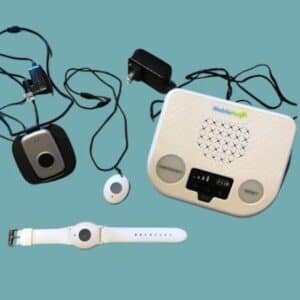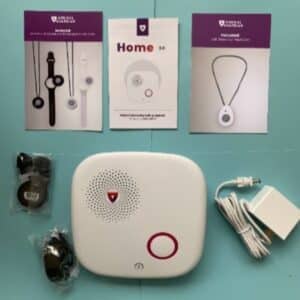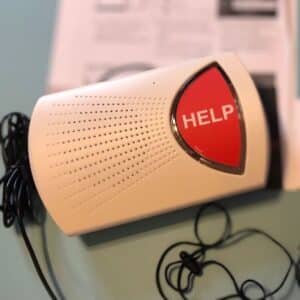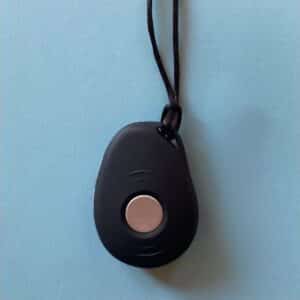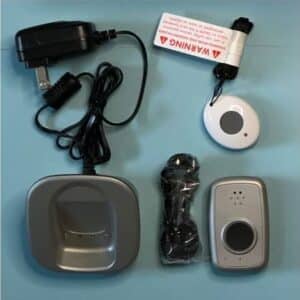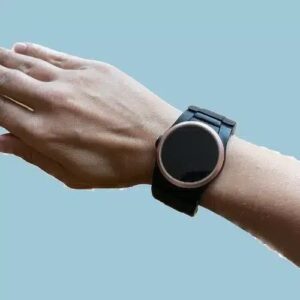Most mobile medical alert systems include a $100–$200 fee on top of the monthly monitoring fee, but MobileHelp doesn’t charge extra fees for most devices. There’s only one device with an extra fee—a $49.95 processing fee for the Classic at-home system—but the company waives it with quarterly, semiannual, or annual payment plans. It’s this lack of fees that led us to designate MobileHelp as “Best for No Extra Fees.” We also like the variety of devices available, including a smart tablet at-home system with games, a photo gallery, and a health database.
7 Best Medical Alert Systems of 2024: Expert Tested & Reviewed
Some people might still associate medical alert systems with bulky, outdated buttons and the “I’ve fallen and I can’t get up!” slogan from nightly infomercials. Fortunately, today’s medical alert devices are modern, discreet, and full of high-tech features, like voice recognition, step tracking, and health vitals monitoring. And most importantly, a 24/7 connection to a monitoring center.
These devices are valuable safety tools for older adults, people at risk of falling, and anyone living alone.
Our Reviews Team researched and tested the top medical alert systems on the market to help you make an informed decision for yourself or your loved one. Let’s take a look at our picks for the best medical alert systems in 2024.
Table 1 Best medical alert systems comparison, as of April 2024
Our comparison table below allows you to easily compare prices and features of the best medical alert systems of 2024. When comparing medical alert systems, pay special attention to connection type, device range, and battery life.
Best medical alert systems of 2024
Other brands to consider
With so many medical alert systems available, our Reviews Team wanted to refine and shorten our top recommendations to help you find the right one for you or your care recipient. We chose the above brands based on our testing experience as well as various price ranges, features, and device options.
GetSafe and Aloe Care Health are not our top picks, but we wanted to mention them here. Both have unique features that may be right for you or your care recipient.
GetSafe
GetSafe is a medical alert system you don’t have to wear. Instead, you place voice-activated and standard wall buttons that are connected to the base station throughout your home. You contact the monitoring center with your voice (say “Call 911” twice), pressing the wall button, or pulling the cord.
GetSafe may be a good option for users who don’t always remember to wear their medical alert system or find the devices uncomfortable. Packages are grouped by the size of your home; they range from one bedroom to four to five bedrooms.
GetSafe drawbacks:
- High equipment fees ($79–$307)
- No landline option for at-home system
- Mobile system can’t be purchased separately
Aloe Care Health
Aloe Care Health is an excellent choice for caregivers who want to closely monitor their care recipient. The base station, called the Smart Hub, includes a motion sensor as well as air quality and temperature monitoring. Caregivers can use the motion sensor to track the user’s daily activity and they’ll receive activity notifications through the caregiver app.
One of our favorite Smart Hub features is two-way calling. The user can make and receive hands-free calls to designated caregivers directly from the base station. Users can also contact the monitoring center with their voice if they’re within range of the Smart Hub by saying “Emergency” two to four times.
Aloe Care Health drawbacks:
- High equipment fees ($99.99–$249.99)
- Only 200-foot range from base station
- No landline option
What is a medical alert system?
A medical alert system is a device that connects to a 24/7 monitoring center with the press of a button. Monitoring center staff can dispatch emergency services, care recipients, or both to the user’s location.
Medical alert systems can foster a sense of security and independence for older adults, those with health conditions, or anyone living alone who may require immediate assistance. [2]Stokke, Randi. The Personal Emergency Response System as a Technology Innovation in Primary Health Care Services: An Integrative Review. JMIR. July 2016. Found on the internet at https://www.jmir.org/2016/7/e187/
“Medical alert services can help reduce the risk of living alone—increasing independence for older adults and providing peace of mind for their caregivers,” said Liron Sinvani, MD, director of the geriatric hospitalist service at Northwell Health in the New York City area. “In the event of a fall or medical situation, an alert system makes help available at the push of an emergency button.”
Christopher Norman, a geriatric nurse practitioner based in New York state, urged us to remember that calling for help instantaneously and the time it takes for help to actually arrive are very different things, and they can vary depending on location.
“Urban versus rural locations are going to have different response times, and connectivity may be an issue in rural settings,” said Norman. “People should have appropriate expectations going into buying any medical alert device. They can be incredibly useful, but they’re not magic.”
How do medical alert devices work?
A medical alert system connects to a 24/7 monitoring center when activated. Depending on the medical alert device, your device may use a button, fall detection sensors, or voice commands to connect to the monitoring center.
Not all medical alert systems have the same connection type—some only connect to landlines, while others use Wi-Fi or cellular connections (such as AT&T or Verizon cellular, which is the same technology your smartphone uses). On-the-go systems, for instance, connect via a cellular network, meaning you’re able to contact the monitoring center anywhere cellular service coverage is available.
Monitored medical alert systems vs. calling 911
A monitored medical alert system offers notable benefits compared to just relying on a call made to 911. Owning a medical alert system can mean a quicker response time when faced with an emergency, around-the-clock monitoring from a dedicated center, location tracking, and most importantly, peace of mind that help will still be available when a caregiver is not around.
Additionally, even though a medical alert system is a monthly expense, it may actually be more cost effective. The monitoring center and services provided by the medical alert company can potentially cost much less in the long run when compared to a 911 call paired with the cost of an expensive ambulance ride.

You don’t need to be an AT&T or Verizon customer to purchase a medical alert system with cellular service— you just need to live within range of the provider’s network. Both cellular networks cover most of the United States, but if you want to confirm you’re in-network, check out the Verizon Coverage Map and AT&T Coverage Map.
Who should use a medical alert system?
There’s no “one-size-fits-all” reason to use a medical alert system. Caregivers and care recipients may choose to purchase a medical alert system for a number of reasons. Maybe you or your care recipient experienced a fall or other medical emergency and weren’t able to get help right away.
Developing a chronic disease, injury, or recent medical condition that affects your mobility and overall health may be another reason to consider 24/7 medical alert monitoring.
Adults age 60 and older are disproportionately affected by chronic conditions, such as diabetes, arthritis, and heart disease. Nearly 95% have at least one chronic condition, and nearly 80% have two or more. [3]National Council on Aging. Chronic Inequities: Measuring Disease Cost Burden Among Older Adults in the U.S. A Health and Retirement Study Analysis. Page 5, Figure 2. April 2022. Found on the internet at https://ncoa.org/article/the-inequities-in-the-cost-of-chronic-disease-why-it-matters-for-older-adults
A medical alert system with fall detectionⓘ A fall detection necklace has a built-in sensor that detects downward motion. It automatically contacts the monitoring center if it detects a fall, even if the user didn’t press the help button. is a good match for anyone with a condition that increases their risk of falling, like Parkinson’s disease, epilepsy, diabetes, COPD, and impaired vision or hearing, said Sinvani. For those with a known heart condition, some medical alert devices are specifically designed for people with pacemakers or defibrillators.
People using four or more prescription medications every day should also consider a fall detection device. Research shows that taking four or more prescribed medications per day can double your risk of falling. [4]Ming, Yu and Zecevic, Aleksandra. Medications & Polypharmacy Influence on Recurrent Fallers in Community: a Systematic Review. Canadian Geriatrics Journal. March 21, 2018. Found on the internet at https://cgjonline.ca/index.php/cgj/article/view/268/381
Those living with dementia can also benefit from using a medical alert system. Some companies offer Bluetooth-enabled products that can be integrated with smart home devices, like window and door sensors. These products can alert a caregiver through their smartphone if their care recipient wanders away from home.
We asked Natali N. Edmonds, a board-certified geropsychologist and founder of Dementia Careblazers, what specific features a caretaker for someone with dementia should look for in a medical alert system.
“Some people with dementia might not remember to use the medical alert device after a fall,” she said. “Having a system that automatically detects the fall can help with this possibility.”
Edmonds added that the device should connect to an app so the caregiver can receive alerts and check in on the person with dementia while they’re away.
Note: A medical alert system should supplement in-person caregiving—not substitute it.
Types of medical alert systems
So, how do medical alert systems work? Learn more about at-home and on-the-go systems below.
At-home medical alert systems
At-home medical alert systems have a base unit that contacts trained staff at a monitoring center and a portable help button that connects to the base unit. You plug the base unit into an outlet in a central location, such as the living room or kitchen, and wear the portable help button as a medical alert necklace or wristband, or carry it in your pocket. This allows you to contact the monitoring center from a different room, and even from outside as long as you’re within range of the base station. Base units also include a battery backup in case of a power outage.
Most at-home systems are available with a landline or cellular connection.
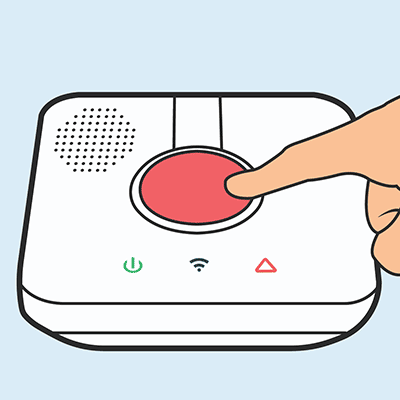
On-the-go medical alert systems
An on-the-go system uses a mobile device with a cellular connection, enabling you to call for help when you’re away from home. Some systems also use a lightweight help button that communicates with the mobile device. You can carry the on-the-go system in your purse or on your belt while wearing the help button around your neck or wrist.
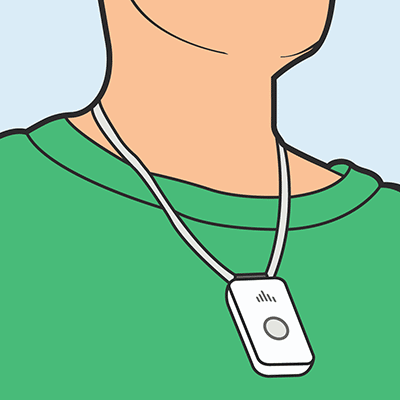
On-the-go medical alerts come in a variety of sizes and styles. Unlike at-home systems, mobile systems don’t need to stay plugged in. They have rechargeable batteries and include a charging cradle that plugs into an outlet.
Many mobile systems are about the size of a pager and can be worn as a necklace or clipped to your pocket or purse. Many brands, like Medical Guardian and Bay Alarm Medical, now offer medical alert smartwatches as an on-the-go option.
Popular medical alert system features
Learn more about common medical alert system features.
- Range: This is the longest distance an at-home base unit can connect with your help button. Device ranges are typically between 200–1,400 feet. Range is not a factor you need to consider with on-the-go systems.
- GPS Tracking: Location detection on medical alert devices is a feature that only applies to on-the-go systems. GPSⓘ GPS technology uses satellites to provide users with positioning, navigation, and timing services. -enabled medical alerts allow monitoring center staff to quickly determine a user’s location during a personal emergency. GPS tracking also allows caregivers to view the user’s real-time location when they’re wearing the device. This is an extremely helpful feature for those caring for someone prone to wandering.
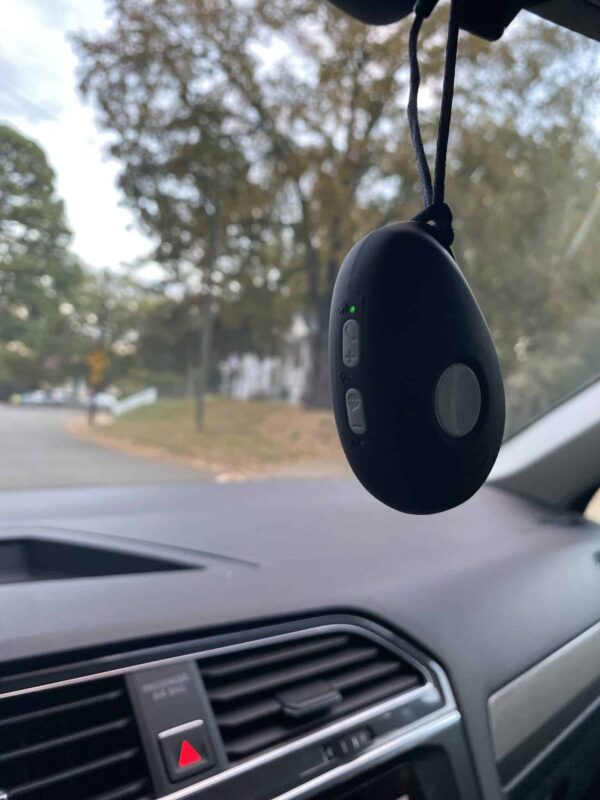
- Fall detection: Using sensors such as accelerometers, which detect motion, fall detection devices are designed to identify a fall and then send an alert to the provider’s monitoring center. Nearly every provider includes a disclaimer on its website stating that no device is 100% accurate. Be aware that false positives (when the device mistakenly detects a fall that hasn’t happened) can occur from things like dropping your device or the device falling off a table.

Research from 2021 and 2023 shows that fall detection devices are more accurate when worn around the neck than on the wrist. Remember this when considering wrist-based fall detection devices like the Kanega Watch or Bay Alarm Medical SOS Smartwatch. In the event of a false fall detection alarm, the company will verify whether you need assistance. [5]Javier González-Cañete, Francisco and Casilari, Eduardo. A Feasibility Study of the Use of Smartwatches in Wearable Fall Detection Systems. Sensors. March 23, 2021. Found on the internet at https://www.mdpi.com/1424-8220/21/6/2254 [6]Lee, Yongkuk, et al. Experimental Study: Deep Learning-Based Fall Monitoring among Older Adults with Skin-Wearable Electronics. Sensors. March 2023. Found on the internet at https://www.mdpi.com/1424-8220/23/8/3983
If fall detection is a feature you’re interested in, see our best medical alert systems with fall detection review.
- Help buttons: Depending on the system you choose, you’ll receive a help button that can be worn as a necklace or emergency life alert bracelet. The help button is lightweight, comfortable to wear, and connects to the monitoring center for 24/7 coverage.
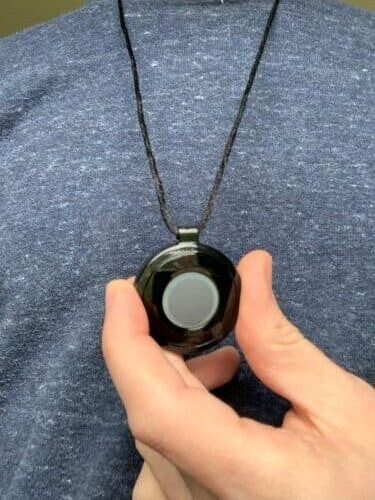
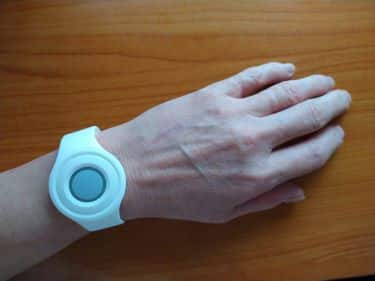
- Battery life: Since at-home systems are plugged into an outlet, they have backup batteries that typically last 30–32 hours if there’s a power outage. On-the-go systems come with chargers and typically last one to five days on a single charge.
- Activity tracking: Tracking your daily activities is a great way to track your steps and ensure you’re getting enough movement throughout the day. Many on-the-go devices now include step trackers that allow you to view your daily steps in your online portal or app. Caregivers can also use activity tracking to monitor a user’s well-being. Drops in normal activity levels could indicate falls, a long lieⓘ A long lie occurs when a person falls and is unable to get up from the floor for an hour or more. Long lies have been associated with several types of long-term health complications. , a medical condition, or other issues that can be noticed and acted on through caregiver activity tracking.
- Caregiver app: Many medical alert systems include a free caregiver app. Features vary by brand, but many apps allow caregivers to track the device’s location, set medication reminders, check battery status, and view a log of monitoring center calls.
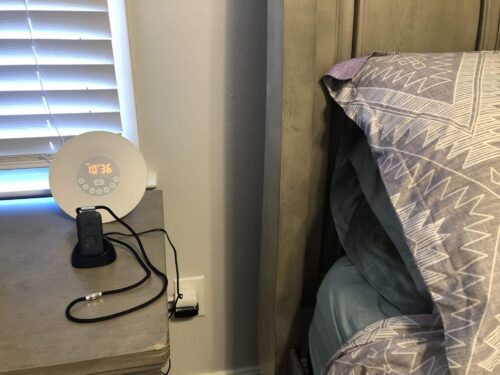
In our Reviews Team survey of 1,000 medical alert system users, automatic fall detection was the top feature our survey respondents wanted with their medical alert system, with 60% of respondents indicating that this feature was important to them. Automatic fall detection was followed by a mobile app for caregivers and GPS location tracking, with 55% and 53% of respondents indicating this feature was important, respectively. [1]NCOA Adviser Medical Alert Systems Survey. 1,000 respondents. Conducted using Pollfish. Launched November 2021
Medical alert system costs
The cost of medical alert systems, also known as personal emergency response systems (PERS), depends on a few different factors. For example, some brands charge an upfront equipment fee, while others rent the equipment to you, waiving the equipment fee.
Starting monthly fees generally range from $20–$35. That doesn’t include one-time equipment fees, which can range from $50–$350, and activation fees of up to $200.
Some systems come with the option to add extra products or services, which can mean added costs, while others might include a few freebies.
Take a look at the four major cost categories below.
Monthly fees
The monthly cost of your system depends on the type you choose. At-home systems tend to be the least expensive, with monthly costs running between $20–$35. On-the-go systems usually cost about $30–$40 per month, but some may cost $50 or more. Bundled systems, which include two medical alert systems, can cost $40 to more than $60 per month.
Here are the lowest starting monthly prices of the best medical alert systems:
Connection type | Model |
|---|---|
| At-home landline | Bay Alarm Medical SOS Home ($24.95) |
| At-home cellular | MobileHelp Classic ($34.95) |
| On-the-go | Bay Alarm Medical SOS Mobile ($34.95) |
| Smartwatch | Bay Alarm Medical SOS Smartwatch ($34.95) |
There are also medical alert systems with no monthly fees that don’t connect to a 24/7 monitoring center. Instead, an unmonitored medical alert system connects directly to 911 or your personal contacts during an emergency. Most don’t offer fall detection, GPS tracking, and other important caregiver features. We don’t recommend these systems.
Equipment fees
You either rent or purchase medical alert system equipment. If you’re charged an equipment fee on top of your monthly fee, you own the equipment and don’t need to return it if you cancel your subscription. High-tech devices like medical alert smartwatches, mobile systems, and smart tablets often have an equipment fee.
Most at-home systems are rentals and don’t include an equipment fee. Unlike purchased devices, you must return rental equipment when you cancel your subscription.
Add-on features
Optional features are a great way to customize your medical alert system to your care recipient’s or your needs. Some popular add-on features include:
- Automatic fall detection: We recommend purchasing fall detection if available. The average cost of fall detection is $10 per month.
- Lockbox: Some companies offer a free lockboxⓘ Typically attached to the outside of your home, a medical alert lockbox is a common add-on accessory that stores a house key, giving emergency responders access to the home. with your medical alert system, while others charge a small monthly fee (about $3) or a one-time fee of up to $30. Monitoring center agents can give the lockbox code to emergency services.
- Medication reminders: Many medical alert systems now offer medication reminders. You can usually set medication reminders in the corresponding caregiver app or online portal. Some brands allow you to add the medication name and dosage to your reminders, while others display a general reminder like, “Take medication.” Depending on your system, medication reminders may come through your phone, display on the medical alert screen or base station, or be a simple beeping sound.
- Multi-person monitoring: You can purchase an extra help button for about $3 per month or a $30 one-time fee to monitor your partner or roommate under the same medical alert system. If you and your partner have different schedules and activity levels, consider a bundle package with two separate systems for one monthly fee.

If using medication reminders with your medical alert system, keep your reminders updated. “Updates at least every month, after every health care provider encounter, and after every hospitalization are highly recommended,” said Norman.
Hidden fees
Hidden fees may include additional activation, initiation, processing, and membership fees. Most top brands will not add in these fees, but it’s best to confirm with a customer service representative when shopping around.
Warranties and Policies
When reviewing medical alert systems, examine the warranty details carefully. Warranties on top systems usually cover replacing worn or damaged equipment with certain exclusions. For example, Bay Alarm Medical provides an optional protection plan for an added fee for a one-time replacement of the base station or device, plus discounts on lost or damaged accessories. Look for a warranty that protects against defects and equipment failure under normal use. Also, consider supplemental protection plans if available, as they can offset costs from damage or loss not covered under the standard warranty. Understanding the warranty and protection options will help you select a medical alert system that provides appropriate coverage.
How to save money on medical alert systems
Unfortunately, Traditional Medicare (Part A and Part B) doesn’t cover medical alert systems, and private health insurance rarely does. Here are some potential ways to save money. [7]Medicare.gov. What Part A Covers Found on the internet at https://www.medicare.gov/what-medicare-covers/what-part-a-covers [8]Medicare.gov. What Part B Covers. Found on the internet at https://www.medicare.gov/what-medicare-covers/what-part-b-covers
- Medicare Advantage (Part C): Some Medicare Advantage plans may cover partial or full medical alert system costs, but plans vary. Check with your insurance provider to see if coverage is available. [9]Medicare.gov. How do Medicare Advantage Plans work? Found on the internet at https://www.medicare.gov/sign-up-change-plans/types-of-medicare-health-plans/medicare-advantage-plans/how-do-medicare-advantage-plans-work
- Flexible spending account (FSA) or health saving account (HSA): Money in an FSA or HSA can be used to pay for a medical alert system. These accounts allow you to set aside money before taxes to help pay for medical expenses and are usually available through an employer. They do have strict limitations, though: FSA funds can’t be used once you’re retired, and you can’t contribute to an HSA when you’re enrolled in Medicare.
- Quarterly or annual payment plans: Some companies lower your monthly fee if you choose a quarterly (pay four times a year) or annual payment plan. For example, the Medical Guardian Home 2.0 has a $37.95 monthly fee, but if you choose an annual plan and pay for a year of service in advance, the monthly fee breaks down to $34.79.
- Seasonal discounts: Medical alert companies may offer discounts around the holidays or other times throughout the year, such as waiving an equipment fee or offering a free service month.
- Organization discounts: You may also qualify for discounts through the U.S. Department of Veterans Affairs (VA) or organizations like AARP. Some local area agencies on aging may offer discounts or partial coverage for a medical alert system. Use the area agencies on aging directory to find available programs in your area by typing in your ZIP code.

“There are a number of organizations, such as the AARP and other not-for-profit area agencies on aging—in Florida, we have the Alliance for Aging, for example—which provide discounts on medical alert systems, and in some cases, the U.S. Department of Veteran Affairs or Tricare may cover a medical alert system at no cost,” said Jeremy Radziewicz, MAcc, chief financial officer at Community Health of South Florida, Inc.

If you’re living on a low to moderate income, you may be eligible for money-saving benefits programs to help you pay for daily expenses. Visit NCOA’s BenefitsCheckUp® to learn more.
How to choose a medical alert system
The best medical alert system for you will depend on your situation and lifestyle. Thinking about your budget and the factors that are most important to you in a device can help you narrow down the options.
These factors will be different for each shopper, but the majority of our survey respondents agreed that fast response time is the most important quality in a medical alert system. This was followed by the system being easy to set up and use, with price ranking as the third most important consideration. [1]NCOA Adviser Medical Alert Systems Survey. 1,000 respondents. Conducted using Pollfish. Launched November 2021
As a starting point, refer back to Table 1 to compare the features and costs of the top medical alert brands. Then use the following tips as a guide when researching the best medical alert systems:
- Evaluate your needs: Consider your day-to-day activities. Do you drive independently and keep an active lifestyle outside your home? If so, a mobile system is probably best for you. If you’re accompanied by a caregiver whenever you run errands or visit family and friends outside your home, you may need an at-home system. We also recommend adding fall detection whenever available.
- Evaluate the providers: Start by reviewing a company’s website. Is pricing information transparent? Can you learn about available features online? Many medical alert brands have an online chat feature, which is a great way to answer quick questions. If you’re more comfortable finding out information over the phone, call customer service to learn more about device features, the trial period, and the brand’s cancellation policy. You can also learn from real customers’ experiences on verified third-party review websites such as Better Business Bureau and Trustpilot.
- Evaluate the products: Take advantage of a company offering a trial period. This way you can make sure you’re comfortable with the medical alert system before committing to it. Confirm the trial period window with a customer service representative before ordering the device. Ask them to clarify if your trial period starts as soon as you order the device or as soon as you receive it.
If you’re a caregiver shopping for a medical alert system, it may be difficult to talk about medical alert systems with your care recipient, especially if they aren’t receptive at first. We asked Sean Marchese, a registered nurse in Orlando, Florida, with more than 20 years of patient care experience, how to navigate this conversation.
“Understanding someone’s main concerns for not using a medical alert device is the best way to learn why they’re hesitant,” said Marchese. “Consider discussing the topic with a health care provider present who can also answer questions and assuage worries.”
Considerations when shopping for a medical alert system
Even if you’ve narrowed down your choices to two or three medical alert system companies, you still have multiple models and features to choose from.
Keep the following considerations in mind to help you narrow down your choices.
Considerations | |
|---|---|
| Device type | We recommend an at-home system if you spend most of your time at home and are accompanied by a caregiver when outside your home. A mobile system may be better if you’re more independent and enjoy on-the-go activities outside your home without a caregiver. |
| Connection | If your area has poor cellular service, a medical alert system with a landline connection may be the right choice. Remember that you must have an active landline connection for the system to connect to the monitoring center. |
| Range | Most at-home systems with a cellular connection have a longer connection range than a landline system. If you have a large home or yard and prefer an at-home system, an at-home system with a cellular connection may be the best option. |
| Battery life | If you’re often away from home, a lengthy battery life is important. Do you find yourself regularly away from home for hours at a time? An on-the-go device with a longer multi-day battery life may be important. |
| Fall detection | Are you or the person you’re buying a medical alert system for at risk of falling or have fallen in the past? You may want a wearable device with fall detection. |
| Water-resistance | Water-resistant help buttons and mobile devices can be safely taken into the shower but cannot be submerged in water, such as while swimming or taking a bath. Waterproof devices can be fully submerged in water. |
Best medical alert systems: Bottom line
Medical alert systems are not one-size-fits-all devices. Older adults and caregivers have different needs, preferences, lifestyles, and budgets, so the right medical alert system will vary for each person.
MobileHelp offers high quality systems without charging extra fees. We liked the brand’s options and its packages providing two systems for one monthly price enough to make it our top pick.
Medical Guardian has impressive at-home and on-the-go systems. Its at-home systems have some of the farthest ranges in the industry, and there are three discreet mobile system options available: a necklace, bracelet, and smartwatch.
Medical Alert may be the best option for those seeking a straightforward, easy-to-use system. Additionally, installation is effortless, allowing users to set up and begin using their devices quickly.
If you’re shopping for a medical alert system for your care recipient, involve them in the selection process as much as possible. Ask your care recipient what styles and features they prefer. You can also frame the trial period as a chance for them to try the device and give you feedback before deciding on a brand. Help them feel empowered by deciding on the right medical alert system together.
Frequently asked questions
Medical alert systems provide users with a way to call for help during emergencies like falls. These systems come in two main formats: at-home base units, or mobile devices that can be worn outside the home.
Wearable medical alert devices typically use cellular service and GPS technology to keep you connected to an emergency call center at all times. Some wearable medical alert devices offer fall detection at an additional monthly cost. Learn more about the best medical alert necklaces, medical alert bracelets, and medical alert watches we recommend.
The best medical alert systems include MobileHelp, Medical Guardian, Bay Alarm Medical, and other companies mentioned in this guide. But ultimately medical alert systems are not one-size-fits-all, and you should find the best medical alert system for your needs by considering things like your budget, what type of device connection you need, and battery life.
Medical alert systems have starting costs between $20–$30 per month. This doesn’t include one-time equipment fees, which can range from $50–$350, and activation fees of up to $100.
Medical alert systems work by connecting you to a 24/7 monitoring center after you push a help button. The monitoring center staff speak with you through your medical alert device, decide whether you need help, and send the necessary assistance.
When choosing a medical alert system, there are several factors to consider. First, think about whether you need a system that operates only at home or also while you’re on the go. Then, choose between wearable systems, typically a necklace or watch. It’s also important to determine whether you are prone to falls and if you will benefit from fall detection. Depending on your budget, you can opt for a more basic device that offers assistance in case of emergencies. If you prefer to spend a little bit more, you can choose more fashionable styles, like necklace pendants or tech-forward options that will help with everything from monitoring your activity to sending you medication alerts. Based on your lifestyle and needs, you’ll want to find the device and brand that works best for you.
Yes, medical alert systems are certainly worth it. They serve a wide variety of purposes, from immediately responding to calls for help in life-threatening situations to giving older adults the confidence to leave home in order to remain active and social. Medical alert devices can also provide peace of mind for caregivers and supplement health services for aging family members. Medical alert systems, or PERS, are a solid layer of protection for people who live with chronic diseases, are at a greater risk of falling, or live alone.
It depends on the type of insurance you have. Most private insurance or Affordable Care Act plans will not cover the cost, and those that do require a doctor’s signature. Your best chance for insurance coverage is if you have long-term care insurance or use Medicaid. In both cases, plans vary according to state. Call your provider to learn more.
Original Medicare, otherwise known as Medicare Part A and Part B, does not cover the cost of the top medical alert systems. Medicare Advantage, also referred to as Medicare Part C, might cover part of the system’s cost. [3]Centers for Disease Control and Prevention. Percent of U.S. Adults 55 and Over with Chronic Conditions. Found on the internet at https://www.cdc.gov/nchs/health_policy/adult_chronic_conditions.htm The plans differ in each state, so if you use Medicare Advantage, call your plan provider to check for coverage. For more information on how to maximize your Medicare benefits, see the in-depth Medicare Guidance on NCOA’s Age Well Planner.
The AARP recommends that older adults use a medical alert system. While the organization doesn’t promote a specific brand, it does provide a discount on Lifeline medical alert systems for AARP members. Learn more about AARP recommended medical alert systems.
Life Alert systems offer less technology and a shorter range, but a higher price tag, than many other medical systems on the market. For these reasons, we do not find Life Alert to be a good value.
MobileHelp, Medical Guardian, and Bay Alarm Medical are better than Life Alert. They offer fall detection, don’t require a contract, and have lower monthly prices than Life Alert.
We don’t recommend Life Alert because it has expensive monitoring and installation fees, requires a three-year contract, doesn’t offer fall detection, and doesn’t offer pricing information on its website. The brand has too many drawbacks compared to other top medical alert systems.
Yes, unmonitored medical alert systems work, but they provide limited protection. Most work by connecting with 911 or predesignated contacts in the case of an emergency. They use either a landline or connect through a cellular plan. Many of these systems are bare-bones and lack important features like fall detection and a caregiver’s app. The most important thing to remember is they do not include 24/7 monitoring coverage, but this does mean they are more affordable and don’t require a monthly fee.
While most medical alert systems have a monthly fee to cover the cost of 24/7 monitoring and emergency response services, there are alternatives. Some companies may offer quarterly or annual payment plans, which could result in overall savings. A few models on the market don’t require a monthly fee, but these typically do not include professional monitoring services. Instead, they function as personal alarms that notify pre-selected contacts or 911 in the event of an emergency. If this type of system interests you, learn more about the best medical alert systems with no monthly fee.
No, most medical alert systems do not require Wi-Fi, but some specialized at-home systems do.
Activity tracking is an optional feature available on some medical alert systems. It uses motion sensors and software to monitor your daily movements and activity levels. Common measurements include:
- Steps taken
- Distance traveled
- Calories burned
- Time spent active vs. sedentary
Activity tracking can provide insight into your physical health and mobility. However, it is not essential for the core function of a medical alert device – contacting help in an emergency.
Have questions about this review? Email us at reviewsteam@ncoa.org.
Sources
- NCOA Adviser Medical Alert Systems Survey. 1,000 respondents. Conducted using Pollfish. Launched November 2021
- Stokke, R. The Personal Emergency Response System as a Technology Innovation in Primary Health Care Services: An Integrative Review. July 2016. Found on the internet at https://www.jmir.org/2016/7/e187/
- National Council on Aging. Chronic Inequities: Measuring Disease Cost Burden Among Older Adults in the U.S. A Health and Retirement Study Analysis. Page 5, Figure 2. April 2022. Found on the internet at https://ncoa.org/article/the-inequities-in-the-cost-of-chronic-disease-why-it-matters-for-older-adults
- Ming, Yu and Zecevic, Aleksandra. Medications & Polypharmacy Influence on Recurrent Fallers in Community: a Systematic Review. Canadian Geriatrics Journal. March 21, 2018. Found on the internet at https://cgjonline.ca/index.php/cgj/article/view/268/381
- Javier González-Cañete, Francisco and Casilari, Eduardo. A Feasibility Study of the Use of Smartwatches in Wearable Fall Detection Systems. Sensors. March 23, 2021. Found on the internet at https://www.mdpi.com/1424-8220/21/6/2254
- Lee, Yongkuk, et al. Experimental Study: Deep Learning-Based Fall Monitoring among Older Adults with Skin-Wearable Electronics. Sensors. March 2023. Found on the internet at https://www.mdpi.com/1424-8220/23/8/3983
- Medicare.gov. What Part A Covers. Found on the internet at https://www.medicare.gov/what-medicare-covers/what-part-a-covers
- Medicare.gov. What Part B Covers. Found on the internet at https://www.medicare.gov/what-medicare-covers/what-part-b-covers
- Medicare.gov. How do Medicare Advantage Plans work? Found on the internet at https://www.medicare.gov/sign-up-change-plans/types-of-medicare-health-plans/medicare-advantage-plans/how-do-medicare-advantage-plans-work




